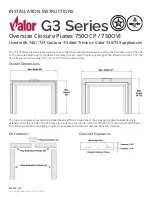
16
Manual: FCCT - Filter Changer Camera Tilter
How to adjust tilt and achieve
micron adjustment with the FCCT?
The FCCT (like the UFC and M68 Baader tilters) essentially consists of 3 pairs of
opposing set screws which independently move the inner tilt mechanics and are easily
accessed from the side using the included hex key (Allen wrench). These screws have
tapered and hardened points that bear against a precision hardened ‘zero-clearance’
steel-counterpart. The direction that each set screw moves the tilter is shown with an
etched arrow next to the individual screw. On the FCCT the extra-long hex-key with
handle also serves as torque-control against overtightening. As soon as the handle
starts to rotate (to "flex") without continuing to turning the screw then the maximum
torque allowed is reached and instead of continuing to increase pressure on that
screw, the other screw in that pair first must be unlocked by a very small amount.
CAUTION:
Never tighten a screw too firmly, only light to medium tension is requi-
red to hold the tilter with zero play . Tightening the screws too hard may damage
the hardened screw tips .
1. Check each set screw to make sure it is
lightly
tightened down (seated). The
screws only need to bear against the internal mechanism with light pressure.
2. To move the tilter in a particular direction, first loosen the opposite direction screw
a very small amount, then lightly tighten the screw that moves the tilter in the
direction you want it to go. Only very small adjustments are needed to square the
mechanical axis, so only move the screws a small amount.
3. Final small tweaks may be made by very slightly increasing the pressure of just a
single screw, or very slightly decreasing the pressure of the opposing screw.
Tips:
• It is recommend that you start with the tilter set at its nominal midway position with
both parts flush. The tilt allowed is approx 0.4 mm to either side.
• The amount of loosening and tightening controls the amount of tilt movement. Al-
ways put the image center into perfect focus first and then work out the edges.
• A simple way to check if overtightening occurs is to closely inspect each single
image frame taken during the adjustment procedure to see if some upper or lower-
side movement (that is: lateral movement) is visible when trying to move one screw
in the system to adjust for more angular tilt. Even slightest lateral movement would
indicate that at least one of the three pairs of screws is severely overtightened, as
each tilter-system is mechanically matched to zero-play.
• In case lateral movement is visible at all in the image frame, then loosen the op-
posing screw by the same amount and it will cause a tilt action immediately. You
will need some time to "get the right feel" just how finely each these three pairs of
screws work as a team, to increase pressure and reduce pressure in order to do the
adjustment in very minute increments. In this way, micron movements are possible.



































